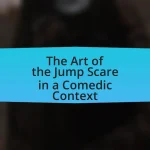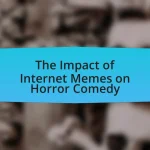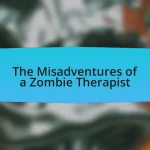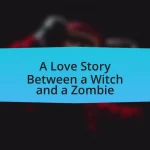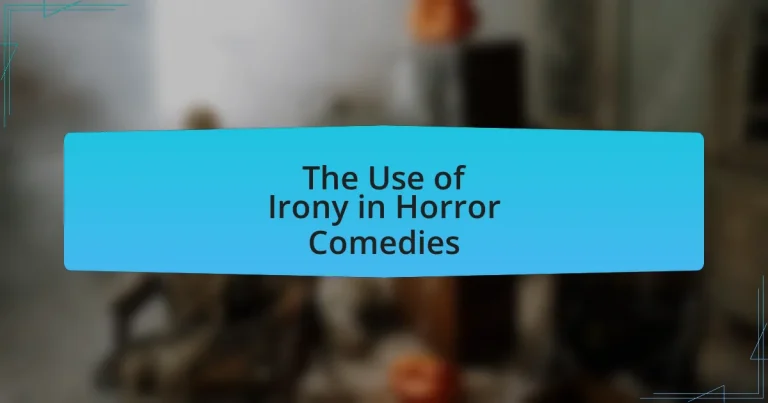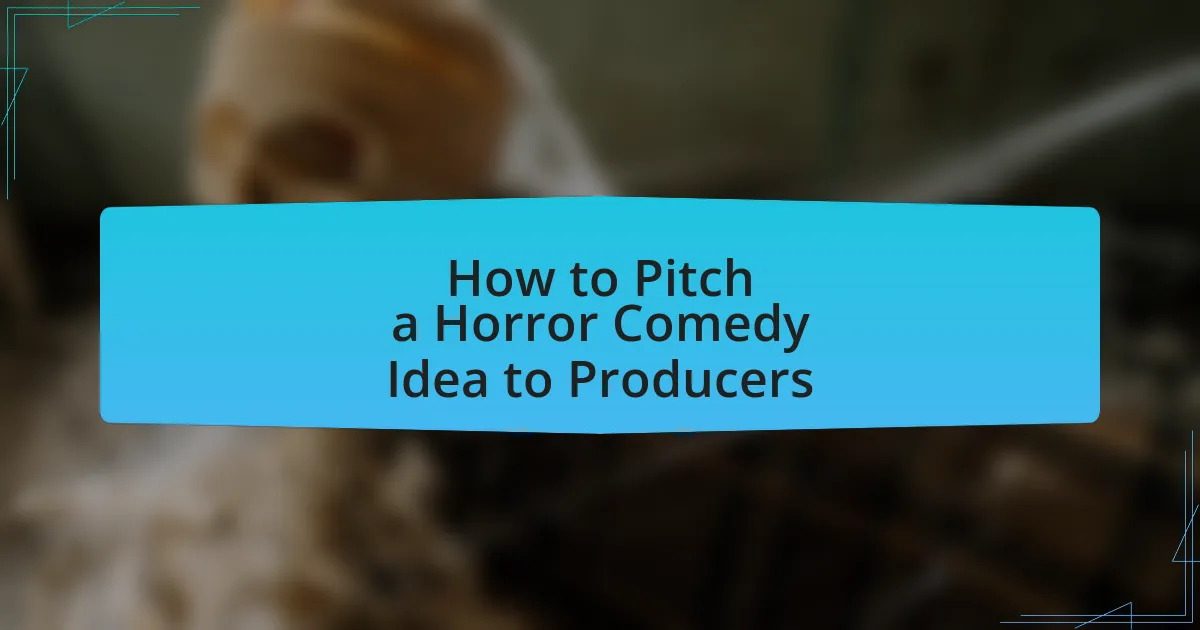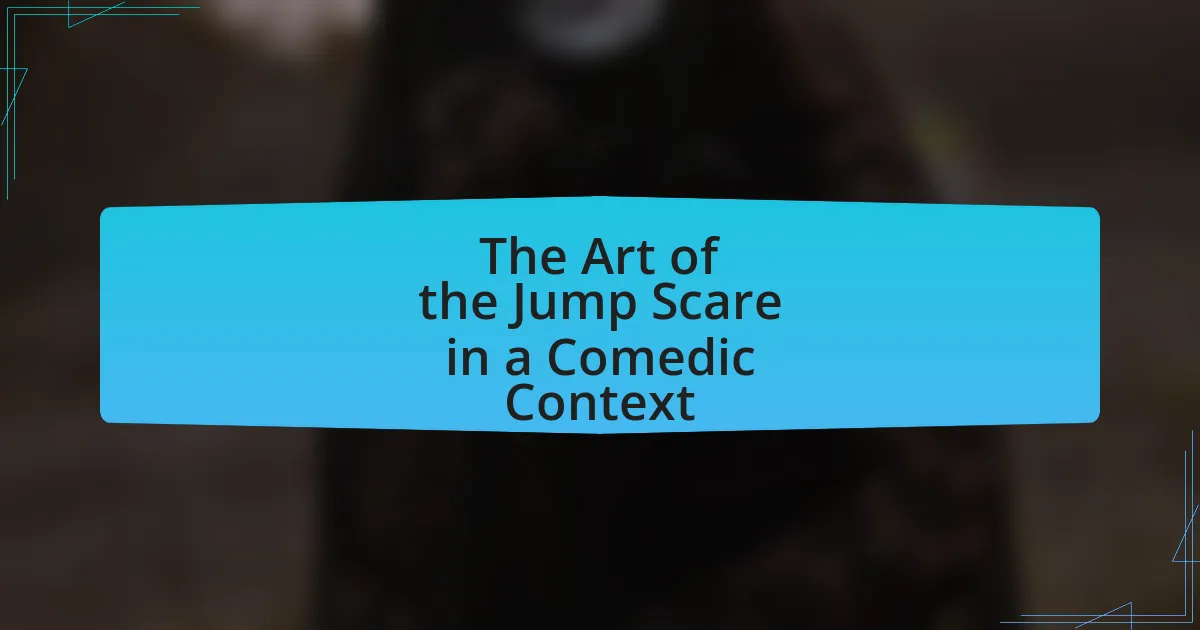The article examines the role of irony in horror comedies, highlighting how it juxtaposes comedic elements with horror tropes to create a unique viewing experience that elicits both laughter and fear. It differentiates horror comedies from traditional horror films by subverting expectations and employing various types of irony, including situational, verbal, and dramatic irony. The article also explores how irony enhances character development, evokes emotional responses, and critiques horror conventions, while discussing notable examples such as “Shaun of the Dead” and “Tucker and Dale vs. Evil.” Additionally, it addresses the potential pitfalls of excessive irony and offers best practices for effectively incorporating irony in horror comedies.
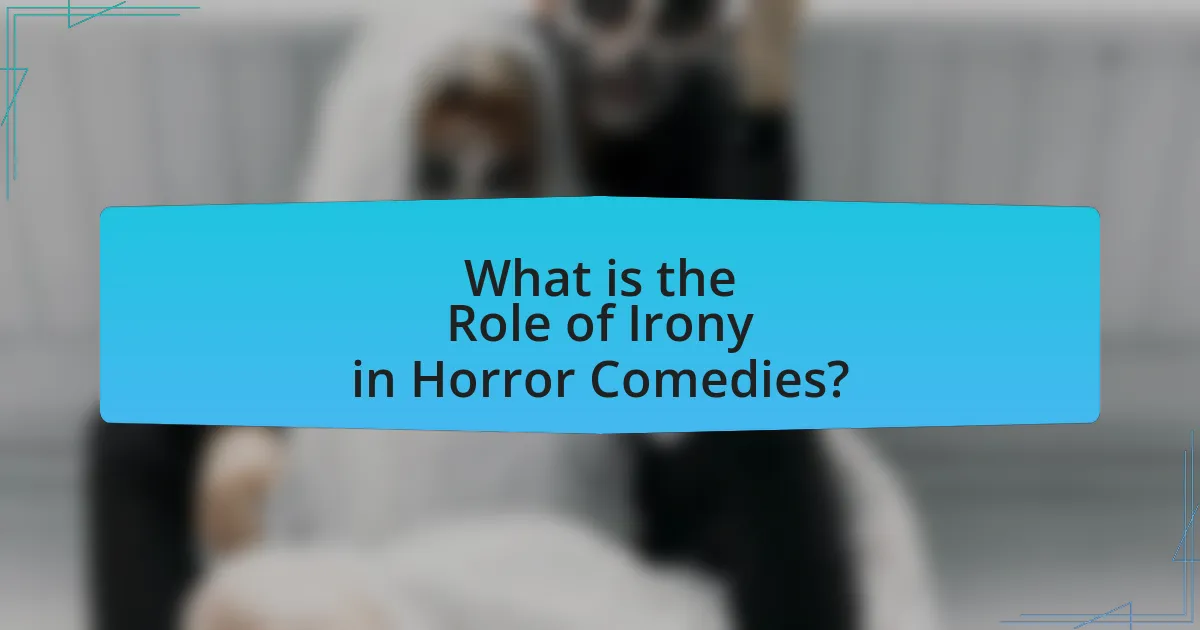
What is the Role of Irony in Horror Comedies?
Irony plays a crucial role in horror comedies by juxtaposing comedic elements with horror tropes, creating a unique blend that elicits both laughter and fear. This interplay allows audiences to engage with the material in a way that subverts traditional horror expectations, often leading to unexpected twists that enhance the overall experience. For instance, characters may find themselves in absurdly dangerous situations while maintaining a humorous perspective, which highlights the absurdity of horror scenarios. This technique not only provides comic relief but also critiques horror conventions, making the genre more accessible and entertaining.
How does irony differentiate horror comedies from traditional horror films?
Irony differentiates horror comedies from traditional horror films by subverting expectations and creating humor through contrasting elements. In horror comedies, ironic situations often arise when characters react to terrifying events in a humorous or nonchalant manner, which contrasts sharply with the serious tone typically found in traditional horror films. For example, in “Shaun of the Dead,” the protagonist’s casual attitude towards a zombie apocalypse highlights the absurdity of the situation, making it comedic rather than purely frightening. This use of irony not only provides comic relief but also critiques horror tropes, allowing audiences to engage with the genre in a more playful way.
What types of irony are commonly used in horror comedies?
Horror comedies commonly utilize three types of irony: situational irony, verbal irony, and dramatic irony. Situational irony occurs when the outcome of a situation is incongruous with what was expected, often leading to humorous or absurd results, such as a character attempting to escape a monster but inadvertently walking into a trap. Verbal irony involves characters saying the opposite of what they mean, often for comedic effect, such as a character sarcastically commenting on a terrifying situation. Dramatic irony arises when the audience knows more about a situation than the characters do, creating tension and humor, such as when viewers are aware of a lurking danger while the characters remain oblivious. These forms of irony enhance the comedic elements while maintaining the horror context, effectively engaging the audience.
How does situational irony enhance comedic elements in horror films?
Situational irony enhances comedic elements in horror films by creating unexpected contrasts between characters’ actions and the outcomes of those actions. For instance, when a character makes a decision that seems logical but leads to a humorous or absurd consequence, it generates laughter while simultaneously heightening the tension typical of horror. This juxtaposition allows audiences to experience both fear and amusement, as seen in films like “Shaun of the Dead,” where the protagonist’s mundane behavior in a zombie apocalypse leads to comedic situations. The effectiveness of situational irony in these films lies in its ability to subvert audience expectations, making the horror elements more palatable and engaging through humor.
Why is irony an effective tool in horror comedies?
Irony is an effective tool in horror comedies because it creates a juxtaposition between expected outcomes and actual events, enhancing both humor and tension. This contrast allows audiences to experience fear while simultaneously recognizing the absurdity of the situation, which can lead to laughter. For example, in films like “Shaun of the Dead,” the characters face zombie threats while maintaining a comedic perspective, highlighting the irony of mundane reactions to extraordinary circumstances. This blend of horror and comedy through irony engages viewers, making them more invested in the narrative while providing relief from tension.
How does irony contribute to character development in horror comedies?
Irony significantly contributes to character development in horror comedies by highlighting the contrast between characters’ expectations and reality, often leading to growth or transformation. This juxtaposition allows characters to confront their fears or flaws in humorous ways, which can reveal deeper aspects of their personalities. For instance, a character who initially appears brave may find themselves in absurdly terrifying situations that expose their cowardice, prompting a journey toward self-awareness. This mechanism not only enhances comedic elements but also facilitates character arcs, as seen in films like “Shaun of the Dead,” where irony underscores the protagonist’s evolution from a mundane life to a heroic role amidst chaos.
What emotional responses does irony evoke in audiences?
Irony evokes a range of emotional responses in audiences, primarily including amusement, surprise, and discomfort. Amusement arises from the unexpected twists that irony presents, often leading to laughter as audiences recognize the incongruity between expectations and reality. Surprise is another significant response, as irony can subvert anticipated outcomes, creating moments that catch viewers off guard. Additionally, discomfort may occur when irony highlights darker themes or contrasts, prompting audiences to reflect on the unsettling nature of the situation. Research indicates that irony can enhance engagement by eliciting these varied emotional reactions, making it a powerful tool in horror comedies.
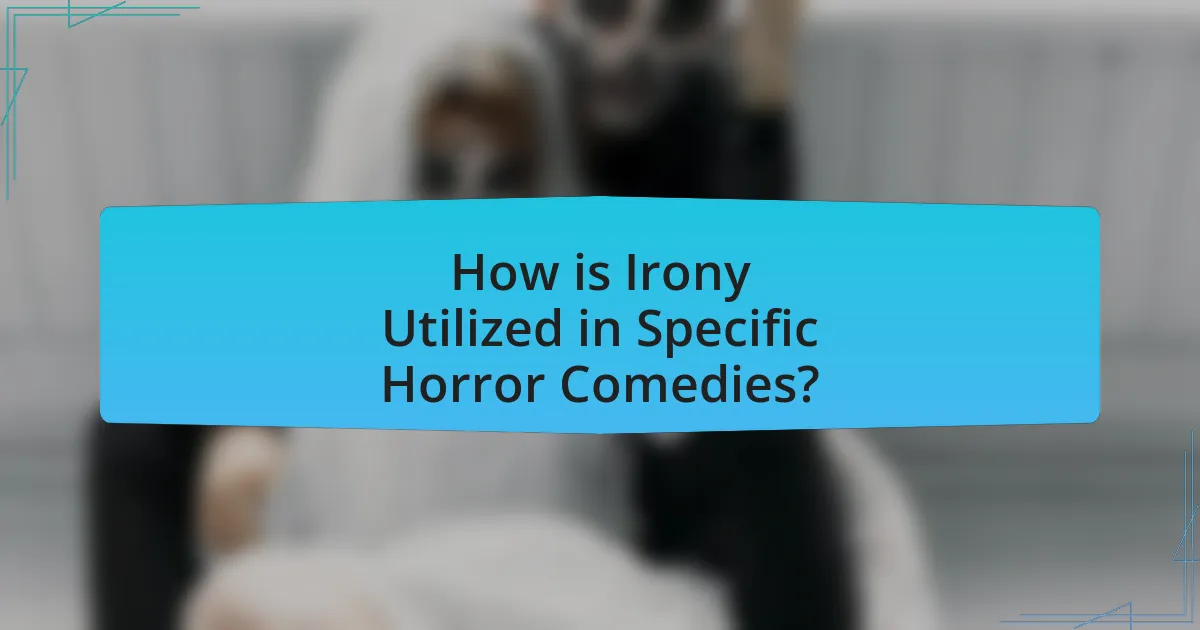
How is Irony Utilized in Specific Horror Comedies?
Irony in specific horror comedies is utilized to create humor through the juxtaposition of expected outcomes and actual events. For instance, in “Shaun of the Dead,” the protagonist’s mundane life contrasts sharply with the zombie apocalypse, leading to comedic situations that highlight the absurdity of both horror and everyday life. This use of situational irony not only elicits laughter but also critiques horror tropes, as characters often make decisions that are humorously contrary to what one would expect in a traditional horror scenario. Additionally, verbal irony is present in films like “Tucker and Dale vs. Evil,” where the characters’ intentions are misinterpreted, leading to comedic misunderstandings that play on audience expectations. These examples demonstrate how irony serves as a tool to subvert traditional horror narratives, making the genre more accessible and entertaining.
What are some notable examples of horror comedies that effectively use irony?
Notable examples of horror comedies that effectively use irony include “Shaun of the Dead,” “Tucker and Dale vs. Evil,” and “What We Do in the Shadows.” “Shaun of the Dead” employs irony by juxtaposing mundane life with a zombie apocalypse, highlighting the absurdity of everyday concerns amidst chaos. “Tucker and Dale vs. Evil” subverts horror tropes by portraying the titular characters as misunderstood rather than malevolent, creating humor from the audience’s expectations. “What We Do in the Shadows” uses irony through its mockumentary style, presenting vampire characters engaging in trivial, human-like activities, which contrasts sharply with their supernatural nature. These films illustrate how irony can enhance comedic elements while simultaneously critiquing horror conventions.
How does “Shaun of the Dead” exemplify the use of irony?
“Shaun of the Dead” exemplifies the use of irony through its juxtaposition of mundane life with a zombie apocalypse. The protagonist, Shaun, is initially portrayed as a slacker who struggles with personal relationships, yet he becomes an unlikely hero in a crisis. This situational irony highlights the contrast between the ordinary and the extraordinary, as Shaun’s attempts to navigate his everyday problems become absurdly intertwined with the chaos of a zombie outbreak. For instance, the film humorously depicts Shaun and his friends using a pub as a safe haven, which is ironic because it is a place associated with leisure rather than survival. This blend of humor and horror underscores the film’s commentary on human behavior in extreme situations, reinforcing the ironic elements throughout the narrative.
What ironic elements are present in “Tucker and Dale vs. Evil”?
“Tucker and Dale vs. Evil” employs several ironic elements, primarily through the subversion of horror tropes. The film presents two well-meaning hillbillies, Tucker and Dale, who are mistakenly perceived as killers by a group of college students. This inversion of expectations creates irony, as the audience knows the protagonists are harmless, while the characters in the film believe the opposite. Additionally, the deaths of the college students occur due to their own reckless actions, further highlighting the irony that their fear of Tucker and Dale leads to their demise. This juxtaposition of perception versus reality serves as a critical commentary on stereotypes and the nature of horror narratives.
How do different filmmakers approach irony in horror comedies?
Different filmmakers approach irony in horror comedies by utilizing contrasting tones and subverting genre expectations. For instance, directors like Edgar Wright in “Shaun of the Dead” blend humor with horror through clever dialogue and situational irony, creating a comedic atmosphere while maintaining genuine suspense. Similarly, filmmakers such as Jordan Peele in “Get Out” employ irony to critique social issues, using humor to highlight the absurdity of racism within a horror framework. This duality not only entertains but also provokes thought, demonstrating how irony can serve both comedic and critical purposes in the genre.
What techniques do directors use to create ironic situations?
Directors create ironic situations through techniques such as juxtaposition, subversion of expectations, and dark humor. Juxtaposition involves placing contrasting elements side by side, highlighting the absurdity of a situation, which can lead to irony. For example, a character may be in a life-threatening scenario while simultaneously engaging in mundane activities, creating a stark contrast that evokes irony. Subversion of expectations occurs when a situation unfolds in a way that defies the audience’s predictions, often leading to humorous or shocking outcomes. An example is a character who is overly confident in a horror setting, only to meet an unexpected fate. Dark humor, which blends comedic elements with serious themes, often highlights the irony of life and death situations, making the audience laugh while reflecting on the absurdity of the circumstances. These techniques effectively engage viewers by creating layers of meaning and enhancing the comedic impact within horror comedies.
How do writing styles influence the use of irony in horror comedies?
Writing styles significantly influence the use of irony in horror comedies by shaping the tone, pacing, and character development, which are essential for delivering effective comedic and horrific elements. For instance, a satirical writing style often employs exaggeration and absurdity, enhancing the ironic contrast between the horror scenarios and the comedic responses of characters, as seen in films like “Shaun of the Dead.” This film utilizes rapid dialogue and witty banter to create a juxtaposition of mundane concerns against a backdrop of a zombie apocalypse, amplifying the irony. Additionally, a more straightforward narrative style can create a sense of realism that makes the ironic moments stand out more starkly, as characters react to horror in unexpected, humorous ways. This interplay between writing style and irony is crucial for engaging audiences and eliciting both laughter and suspense.
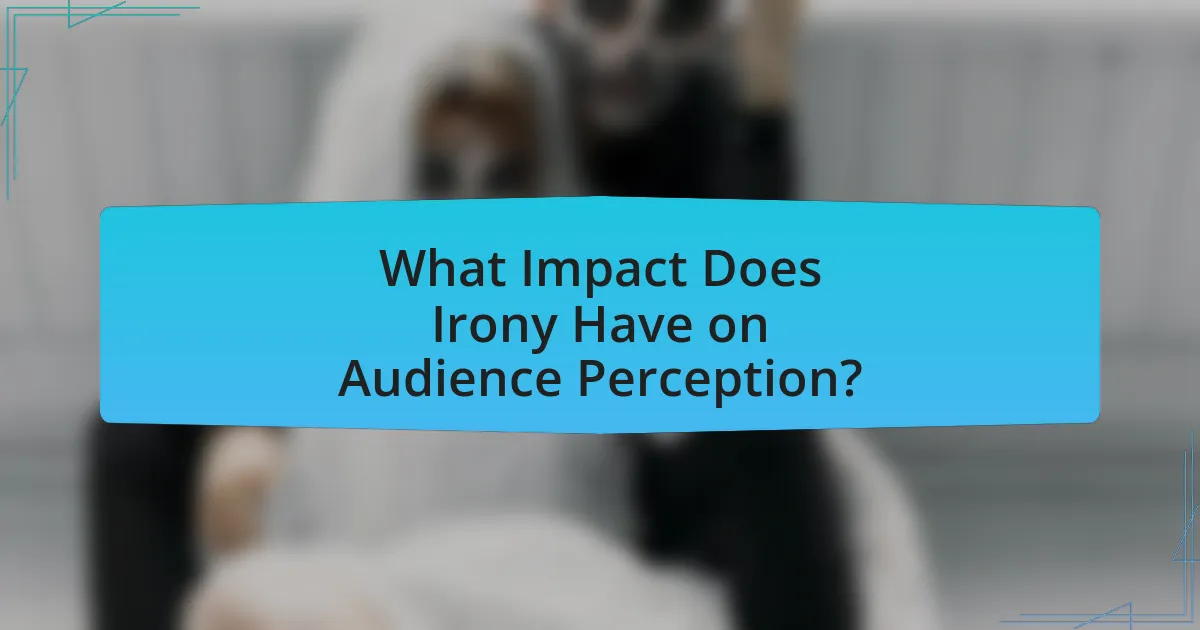
What Impact Does Irony Have on Audience Perception?
Irony significantly shapes audience perception by creating a contrast between expectations and reality, which enhances engagement and emotional response. In horror comedies, this juxtaposition often leads to humor derived from the absurdity of situations that would typically invoke fear, thereby altering the audience’s emotional state. For instance, a character might face a terrifying scenario while delivering a witty remark, prompting laughter instead of dread. Research indicates that this blend of humor and horror can increase viewer enjoyment and retention of the material, as seen in films like “Shaun of the Dead,” where ironic elements are pivotal in redefining traditional horror tropes.
How does irony shape audience expectations in horror comedies?
Irony shapes audience expectations in horror comedies by subverting traditional horror tropes and creating a sense of playful dissonance. In horror comedies, the juxtaposition of comedic elements with horror scenarios leads audiences to anticipate unexpected outcomes, often resulting in humor derived from the absurdity of the situation. For example, characters may knowingly engage in behaviors that would typically lead to their demise in a standard horror film, such as investigating strange noises, which creates a comedic tension that contrasts with the expected fear response. This use of irony not only enhances the comedic effect but also allows audiences to engage with the narrative in a more self-aware manner, as they recognize the clichés being parodied.
What role does irony play in subverting horror tropes?
Irony plays a crucial role in subverting horror tropes by creating a contrast between expected outcomes and actual events, thereby challenging audience perceptions. In horror comedies, irony often manifests through self-referential humor, where characters acknowledge their situation in a way that defies traditional horror logic, such as making jokes about common horror scenarios. This technique not only provides comic relief but also critiques the clichés of the genre, as seen in films like “Scream,” where characters discuss horror movie rules while simultaneously navigating a real-life horror situation. By employing irony, creators can effectively dismantle the tension typically associated with horror, allowing for a fresh perspective that engages viewers in a more playful manner.
How does audience familiarity with horror conventions affect their reception of irony?
Audience familiarity with horror conventions enhances their reception of irony by allowing them to recognize and appreciate the subversion of expectations inherent in ironic humor. When viewers are well-versed in typical horror tropes, such as jump scares or the “final girl” archetype, they can more readily identify moments where these conventions are playfully twisted or mocked. For instance, a character who knowingly engages in behavior that would typically lead to their demise—like investigating a strange noise—can elicit laughter rather than fear, as the audience understands the irony of the situation. This recognition is supported by studies indicating that familiarity with genre conventions increases the enjoyment of ironic content, as it relies on the audience’s ability to discern the contrast between expected outcomes and actual events.
What are the potential pitfalls of using irony in horror comedies?
The potential pitfalls of using irony in horror comedies include undermining suspense, alienating audiences, and diluting emotional impact. When irony is overused, it can reduce the tension that is essential for horror, as viewers may not take threats seriously. Additionally, audiences may feel disconnected if the humor detracts from character development or the stakes of the narrative, leading to a lack of investment in the story. Furthermore, the emotional resonance of horror can be weakened when irony overshadows genuine fear or empathy, resulting in a less effective overall experience. These pitfalls highlight the delicate balance required in blending humor and horror effectively.
How can excessive irony detract from the horror elements?
Excessive irony can detract from horror elements by undermining the tension and emotional engagement necessary for effective scares. When irony is overused, it creates a distance between the audience and the narrative, leading to a lack of genuine fear or suspense. For instance, studies in film theory indicate that horror relies on the audience’s ability to empathize with characters in peril; excessive irony disrupts this connection, making it difficult for viewers to invest emotionally in the characters’ fates. This detachment can result in a comedic atmosphere that dilutes the intended horror, as seen in films where humor overshadows the threat, ultimately reducing the impact of the horror elements.
What are common missteps filmmakers make when incorporating irony?
Common missteps filmmakers make when incorporating irony include failing to establish a clear tone, which can confuse the audience about whether to take scenes seriously or humorously. Additionally, filmmakers often misjudge the timing of ironic moments, leading to a lack of impact or coherence in the narrative. For instance, if irony is introduced too late or too early, it can disrupt the flow of the story. Furthermore, filmmakers may overlook the importance of character consistency; if characters do not react appropriately to ironic situations, it can undermine the intended effect. These missteps can detract from the overall effectiveness of irony in horror comedies, where the balance between humor and horror is crucial for audience engagement.
What are some best practices for effectively using irony in horror comedies?
To effectively use irony in horror comedies, creators should establish a clear contrast between expectations and reality, allowing humor to emerge from the absurdity of situations. This can be achieved by subverting typical horror tropes, such as having characters react inappropriately to terrifying events, which creates comedic tension. For instance, a character might nonchalantly discuss their plans for the weekend while a monster lurks nearby, highlighting the irony of their obliviousness. Additionally, employing self-referential humor, where characters acknowledge their roles within the horror genre, can enhance the ironic effect. This technique has been successfully utilized in films like “Scream,” where characters are aware of horror clichés, making their situations both funny and frightening.

